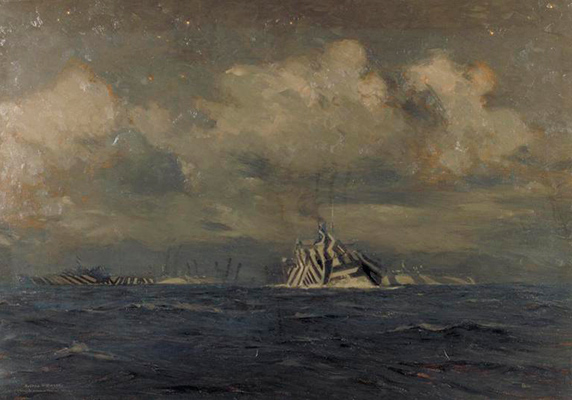Norman Wilkinson CBE, born in 1878, was a British artist predominantly known for his work with oils, watercolors, drypoint, and later, WW1 merchant vessels. Wilkinson was as a wartime camoufleur (French slang for “to disguise”), who designed and implemented military camouflage. This type of concealment was dubbed “Dazzle Painting” or “Dazzle Camouflage”. The term camoufleur was originally given to a person serving in a World War I French military camouflage unit.

Hiding in Plain Sight
During World War I, Wilkinson was serving in the Royal Navy Volunteer Reserve, assigned to submarine patrols in the Dardanelles, Gallipoli and Gibraltar. In 1917, he found himself on a minesweeping operation at HMNB Devonport. Around this time, German U-boat torpedo attacks were doing a lot of damage to British forces, sinking close to eight ships per day. In the midst of these losses, Wilkinson had a flash of genius.
He came to the conclusion that because it was near impossible to hide something as large as a ship in the ocean, the question became about what a ship could do to make it a more difficult target to aim at through an enemy periscope. In other words, it was the real life equivalent of the ship having its camouflage unit levelled to max. The ship was painted not for low visibility, but to obscure its form so enemy vessels didn’t know which direction she was heading.

How It Works
Dazzle Camouflage was also known as “razzle dazzle” or “dazzle painting” and was just one of the methods used for concealing vessels during World War I. Other methods were also used or prototyped: “blending” or “crypsis” was a paint scheme that attempted to hide a ship from view; “deception” made a ship appear smaller; “counterillumination” was a method employed to hide a darkened ship against the slightly brighter night sky.
However, World War I wasn’t the first time ship camouflage was used. On the contrary, records date back from the 3rd century, in the book Imagenes, that details how Mediterranean pirate ships were painted blue-gray in order to conceal them.
Dazzle Camouflage worked by having complex geometric shapes in contrasting colors that interrupted or intersected each other. Dazzle didn’t offer concealment but functioned to make it difficult to guess a target ship’s range, speed and heading. In 1919, Wilkinson said that the dazzle focused more on misleading the enemy to a ship’s position rather than affect the success of the enemy’s weapons.

Of the camouflage, Wilkinson said:
The primary object of this scheme was not so much to cause the enemy to miss his shot when actually in firing position, but to mislead him, when the ship was first sighted, as to the correct position to take up. Dazzle was a method to produce an effect by paint in such a way that all accepted forms of a ship are broken up by masses of strongly contrasted colour, consequently making it a matter of difficulty for a submarine to decide on the exact course of the vessel to be attacked.
Wilkinson’s Crew
There were some initial tests before Wilkinson’s plan was utilized by the British Admiralty. He was put in charge of a naval camouflage unit and found himself at the Royal Academy of Arts’ studios. Wilkinson had around two dozen artists and art students working with him, ranging from camoufleurs, model makers, and construction plan preparators. Together, they crafted dazzle camouflage schemes, tested them in miniature, and prepared construction diagrams that could then be used by other artists at the docks to paint the actual ships. Wilkinson’s work also took him to Washington D.C. where he consulted for the U.S. Navy.
Each Dazzle scheme was designed to be unique in the hopes of making different classes of ships undetectable to the enemy. This resulted in many dazzle schemes being tried and tested, but the evidence for their success was mixed. Due to the sheer amount of different schemes out in the open, it was a challenge to determine which were important, and if the various color schemes were effective.
The Dazzler’s Legacy
After World War I, when Wilkinson applied for credit to the Royal Commission on Awards to Inventors, he was challenged by John Graham Kerr. Kerr has developed his own disruptive camouflage paint scheme earlier in the war. But at the end of legal proceedings, Wilkinson was officially declared the inventor of dazzle camouflage and awarded monetary compensation.
In World War II, Wilkinson was called upon again. However, this time he was assigned to the British Air Ministry. Painting ships had fallen out of favor, and concealing airfields was his new artistic calling.
Wilkinson also continued his work as an artist, where his marine paintings are on display at the National Maritime Museum at Greenwich, Royal Academy, and Royal Society of British Artists, to name a few.